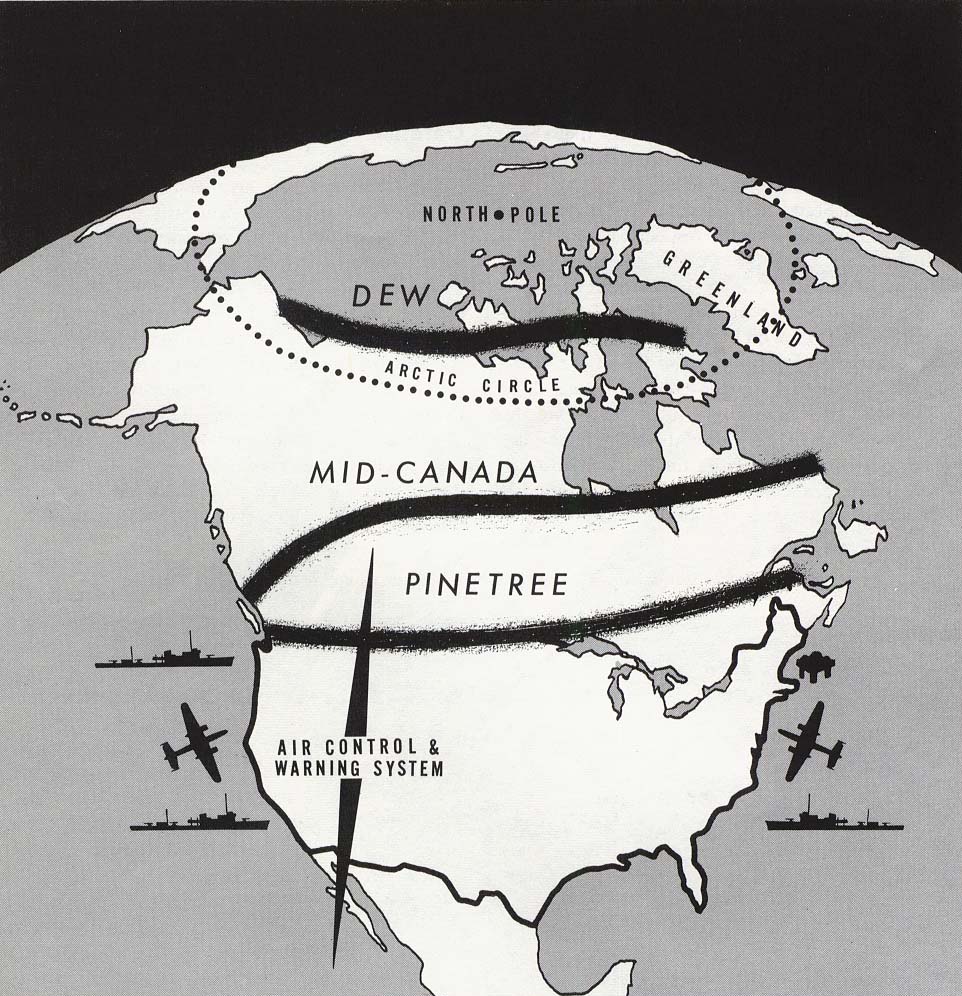I’m not sure how I stumbled upon the Pinetree Line. It seemed to be a particularly descriptive term though. So I guess I tucked it away on my list of “things to ponder later.”
It was a Cold War manifestation, an effort by Canada and the United States to provide an early warning system should the Soviet Union send bombers over the North Pole to shower North American cities with nuclear explosions. Cheery thought, eh? The Pinetree Line ran basically along the low-50’s parallels north. This also happen to be roughly where deciduous trees gave way to conifers of the boreal forests.

There are plenty of sources of information about the Pinetree line. These include a Wikipedia article, a Pinetree Line homepage, and a map on Radomes.org – The Air Defenses Radar Veterans Association.
The Need
The “duck and cover” era of the early 1950’s was a fearsome time. The world could end at any moment. Everyone understood the terrible effects of nuclear weapons, and worse, the technology diffused and proliferate amongst adversaries. Governments needed to develop defenses for this terrible threat. One such countermeasure consisted of a line of radar stations strung between the Pacific to Atlantic coasts, and then heading north towards Baffin Island, the so-called Pinetree Line.
However, they approached obsolescence almost from the first day. The military designed them to provide a final line of defense, a last-ditch warning of Soviet bombers flying over Canada. Unfortunately the Soviets switched to jet-powered aircraft and the potential warning time dropped even further. Plus, the radar technology used on the line had trouble detecting airplanes flying close to the ground. That wasn’t a good combination.
So the military added radar stations further north with new technology to address the deficiencies. Stations along the Pinetree Line started being decommissioned by the end of the decade. A few managed to hang on stubbornly even into the 1980’s.
The Places
The locations selected for individual radar sites varied widely. Sites included Royal Canadian Air Force bases, international airports, remote mountaintops and even rocky islands in the barren north.
The experiences of the servicemen must have varied considerably as well. I imagine someone stationed on an outcrop in what is now Nunavut must have felt a kinship with 19th Century lighthouse keepers. Meanwhile, those at RCAF Station Comox near a town of 12,000 residents might have enjoyed considerably greater amenities. Veterans groups remain active and sometimes share messages related to their experiences protecting North America along the Pinetree Line.
Remnants
One can still see evidence of the old Pinetree Line although time has begun to take its toll. Here are a few that I located:

Cold Lake C-36 in Alberta is now part of the Cold Lake Museums (map). This may be one of the few places where one can easily and legally access a former site on the Pinetree Line. Additionally visitors can view several aircraft on display including a CF-5 Freedom Fighter, CT-133 Silver Star and CT-134 Musketeer, plus three other collocated museums. This would be at the top of my list if I ever visited the area.
Resolution Island N-30 in Nunavut makes my list because it’s hard to imagine any place more desolate and remote. There isn’t so much as a tree or any other plant life within view. It’s no more than barren rock with a few huts and the winters must have been brutal. It must have taken a special person to work here.
I like Falconbridge C-9 outside of Sudbury, Ontario simply for truth in advertising. They weren’t making any attempt to hide its function. The site is located right along Radar Road. There’s even a Radar Base Church.
Totally Unrelated
I developed a map of all United States counties with fewer than one person per square mile a couple of weeks ago in More Land than People. The blog “Data Pointed” has taken this to an entirely different level, a map of every Census Block with fewer than one person per square mile. Wow! This one shouldn’t be missed. It puts my pitiful attempt to shame.

Leave a Reply